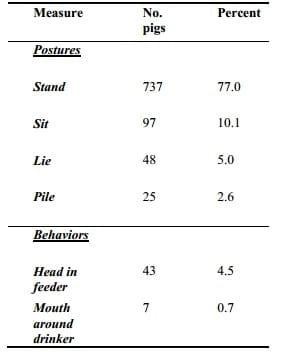Behaviors and postures of nursery aged pigs
When Nursery Pigs are not Approaching a Human Observer
Published: July 17, 2012
By: Shawna Weimer, Anna Johnson, Kenneth Stalder, Locke Karriker (Iowa State University), Thomas Fangman (Boehringer Ingelheim Vetmedica Inc., St Joseph, MO)
Summary and Implications
The objective of this experiment was to determine the behaviors and postures of nursery aged pigs when classified as "not approaching" a human observer when using a digital image. A total of 1,817, ~6 wk old mixed sexed nursery pigs were used. Pigs were housed in commercial nursery pens. The approachability of pigs followed procedures used by Fangman et al., (2010). Pigs were classified into three categories (1) Approachability (2) Lookand (3) Not. Not pigs were further descriptively categorized into four postures (stand, sit, lie and pile) and two behaviors (head in feeder and mouth around drinker). Results will be presented descriptively. A total of 860 pigs were either classified as approaching the observer or looking at the observer, and 957 classified as "Not" (52.7%). Of those pigs classified as "Not" the majority were standing, followed by sitting, and only 2.6% of pigs were classified as piling. Therefore, in conclusion, 97.3% of pigs classified as "Not", were engaged in behaviors and postures not considered to be fearful of the human in their pen.
Introduction
There is still not a universally agreed and accepted behavioral methodology that can be conducted on-farm to assess a pigs' approachability to a human in their home pen. This can be attributed to numerous challenges, for example, the sensory perception of the pig, age, group size, and previous caretaker-pig interaction. There have been numerous tests used to determine the level of fear in a variety of farm species, for example the open field tests, and human and novel approach. The term "willingness to approach" has been proposed to be a more positive alternative to "fear", describing pigs approaching or looking at the human in their home pen. However, if pigs do not get categorized as approaching or looking then what other behaviors / postures are these pigs engaging in? The objective of this experiment was to determine the behaviors and postures of nursery aged pigs when classified as "not approaching" the human observer using a digital image.
Materials and Methods
Animal care: Animal care and husbandry protocols for these experiments were overseen by the company veterinarian and farm manager. The protocol was based on the U.S. swine industry guidelines presented in the swine care handbook and the Pork Quality Assurance Plus™ (2010). The protocol for this experiment was approved by the Iowa State University Institutional Animal Care and Use Committee (#2-11-7080-S). The experiment was conducted on 8 March 2011 at a commercial nursery site situated 128.7 km (80 miles) SW of Ames, IA.
Animals and location: A total of 79 pens in two rooms (40 in room 1 and 39 in room 2) were used. A total of 1,817 ~6 wk old mixed sexed nursery pigs, weighing ~25.4 kg were used. There were ~20 pigs/ pen giving each pig 0.3 m2/pig.
Diets, housing and husbandry: The ceiling height in the nursery rooms were 2.6 m. Pens measured 1.8 m width x 3 m in length with steel dividers (81.3 cm height) between pens and one front steel gate at the front each nursery pen measured 91.4 cm height. Pens were situated with 10 pens on the right, 10 on the left and 20 in the center separated by two alleyways (76.2 cm wide). Feeders were green and circular with a radius of 55.9 cm and height of 81.4 cm (Osborne, Osborne, KS). Pigs has ad libitum access to a meal-grind diet (1510 kcal per kg metabolizable energy [ME] and 18.1% crude protein [CP] formulated to meet requirements (NRC, 1998). Diets were provided in a 5-hole feeder with a feed capacity of 76.2 kg. Each pen contained one stainless steel nipple drinker (Suevia Haighes, Kircheim, Germany) on the opposite side of the feeder, except for end pens where the drinker was located on the side of the feeder farthest from the alleyway. Polygrate flooring (12.7 mm gauge slats; Faroex Ltd., Gimli, Manitoba, Canada) was utilized in all pens. Twenty fluorescent lights were turned on at 7:00 am for daily chores and then were turned off around 16:00 pm. Two night lights were on 24-h a day. Rooms were automatically ventilated using either two pit fans (Osborne, Osborne, KS) with variable speed, 18 inlets and wall fans(Osborne, Osborne, KS) set at 5 CFMs/pig and contained two heaters (L.B. White, Onalaska, WI) per room set at 0.5 oC below set point. Average room temperature was 23.5°C. Caretakers observed all pigs twice daily.
Treatments: Pigs were classified into three categories (1)
Approachability was defined as any part of the pigs' body touching the human observer (2) Look was defined as eye contact (both eyes) with the observer and (3) Not was defined as pigs not previously classified as WTA or Look. Not pigs were further descriptively categorized into mutually exclusive postures and behaviors. Postures;
Standing: upright position with all four feet on the floor.
Sitting: Most of the pigs' body weight and the posterior of its body trunk were I contact and supported by the ground.
Lying: Side contacting the ground or underside contacting the ground.
Piling: Two or more feet off of floor with body on top of a pen mate. Behaviors;
Head in feeder: head down in feeder and Mouth around drinker: mouth on nipple of drinker.
Approachability methodology: The observer entered the pen and walked to the right corner of then pen. She immediately crouched down, extended and held still the left leather-gloved hand and began a stop watch, avoiding eye contact with the pigs for a 15-s period. At the conclusion of the 15-s period, the observer raised her head, took a digital image using the wireless remote and simultaneously scanned the nursery pen to record three pig behavioral categories. After counting all pigs in the pen, the observer retraced her steps and exited the nursery pen. The observer then proceeded to all pens in the room in "a side-to-side fashion until all pens had been entered scanned and recorded (Fangman et al., 2010). Results will be presented descriptively.
Results and Discussion
A total of 860 pigs were either classified as approaching the observer or looking at the observer (47.3%), with 957 classified as "Not" (52.7%). Of those pigs classified as "Not", the majority were standing, followed by sitting, and only 2.6% of pigs were classified as piling (Table 1). Therefore, in conclusion 97.3% of pigs classified as "Not" were engaged in behaviors and postures not considered to be fearful of the human in their pen.
Table 1. Counts and percentages for pigs classifed as "Not".

Acknowledgements
Boehringer Ingelheim Vetmedica Inc. for funding.
This research report is part of the Iowa State University 2012 Animal Industry Report, supported by the Iowa Agriculture and Home Economics Experiment Station and originally published at the Iowa State University website, January 2012. Engormix.com thanks the researchers involved in this project and the Iowa State University for this huge contribution.
Related topics:
Authors:
Iowa State University
Recommend
Comment
Share

Would you like to discuss another topic? Create a new post to engage with experts in the community.






